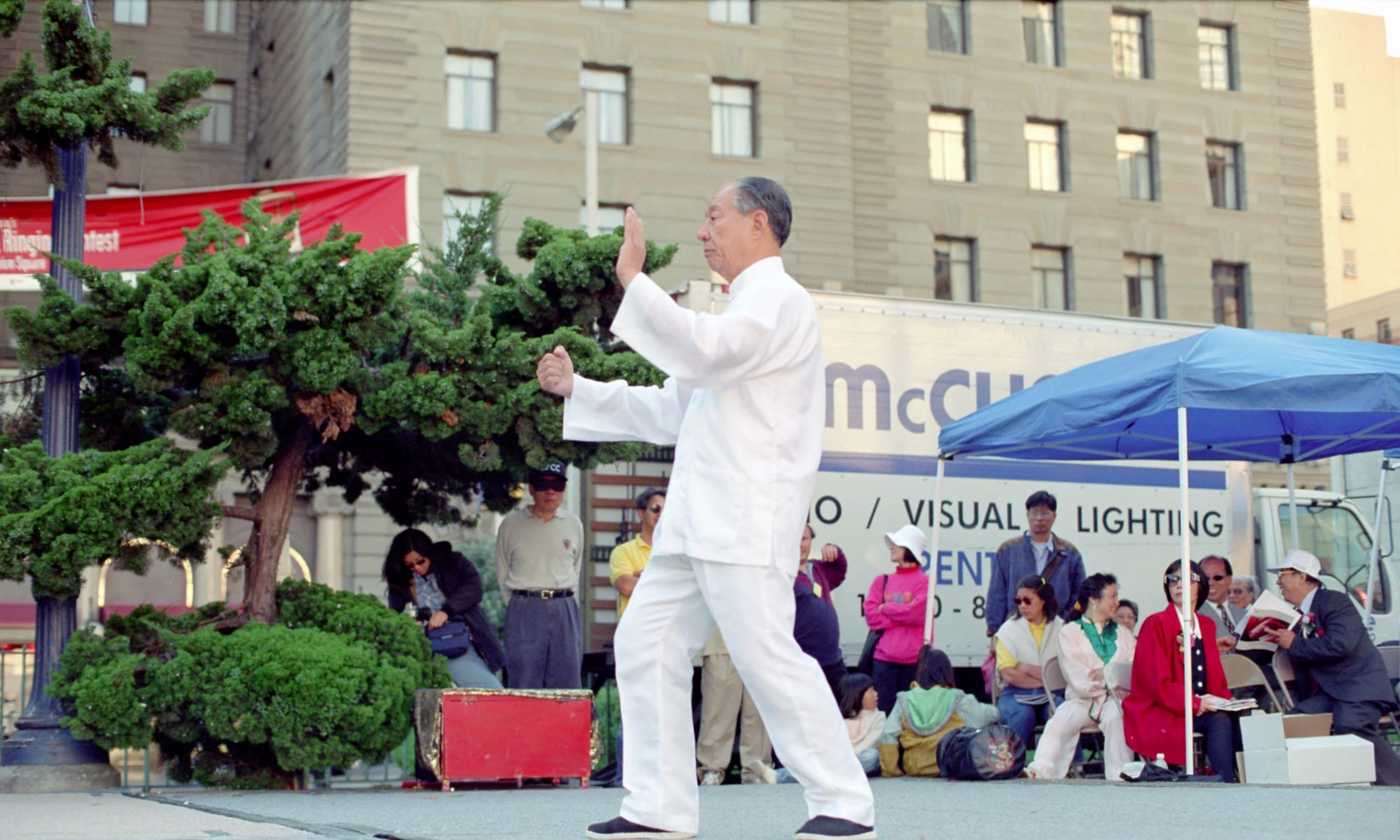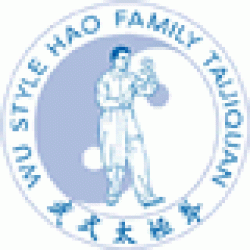Introduction to Wu (Hao) Style Tai Chi
By LIU JISHUN
partial excerpts from public speech, Sunnyvale, CA, 9/4/99, originally in Chinese
Wu (Hao) style is one of the five main tai chi styles in China. It puts much emphasis on some torso and internal requirements. Some tai chi students might then have the misconception that only internal requirements are important, not the external forms. The truth is all tai chi study starts from external and works into internal requirements. Advanced study of tai chi requires not only much investment of time and energy, but also good understanding of certain requirements. Wu (Hao) style has well-documented theories and its teaching is based on these theories.
Today we’ll touch upon things we should know in practicing Wu (Hao) style. All tai chi styles emphasize on dong (movement) and jing (stillness). tai chi is good for health mainly because it strengthens one’s jing [spirit], qi [internal energy], and shen [mind]. The key is in the manipulation of yi [mind or mind intent], to achieve the state of utmost calmness. This calmness is a state of highly focusing on one’s body, to examine if all parts of the body is natural and relaxed. According to tai chi theories, during the practicing of forms one has to be sensitive to not only one’s own body, but also to the surrounding environments. This is why we should practice the forms in a quiet place so that it’s easier to build up this sensitivity.
Calmness
There are five key words in Wu (Hao) style theories. The first one is jing [calmness or stillness], or xin gui jing [keep the mind calm]. We’ll elaborate on this today:
I always remind my students to remain calm during the practice. Only when one is calm can one focus one’s mind. True tai chi calls for the utmost focused state of mind. Only then can one has the clearest grasp of one’s sensitivities (or feelings): knowing if all parts of the body are relaxed and comfortable. This feeling must be very clear to you. Only then can you tell if your moves follow tai chi’s requirements.
There are some common quotes in tai chi theories. For example, “if one part [of the body] moves, all parts [of the body] move“: if your hands move, your legs and your body have to move in synchronicity. Furthermore, “there has to be continuity between movements [in practicing the forms].” These two principles (one part moves, all parts move and continuity between movements) can strengthen our body’s functioning. Earlier when we were practicing the forms, as soon as our hands move [which is like the branches of a tree], we have to ask ourselves where the root is and whether the root is also moving in harmony, otherwise the tree will fall. As we move we have to ask if we have good support from the foundation. This is also the meaning of “if one part moves, all parts move.” These principles sound simple, but are not easy to maintain throughout the entire [49] forms, especially when you also need to maintain evenness.
To sum up, we have to be jing [in a very calm state of mind], so that we have clear sense of all parts our body. Then we use yi (mind) to direct all our moves, so that we have full control of every move. This full control is referred to as qi shi in tai chi, such as whether one has large or small qi shi. For example, if one starts with 30 lb of force [at the beginning of the forms], one should maintain this level of force throughout the forms. It’s like a boat floating in the water, you need to maintain a constant level in the water. You cannot have ups and downs, which is considered undesirable in tai chi. Take Wu (Hao) style’s yun sho (cloud hand) for example: your whole body has to move in coordination in all aspects: top to down, external to internal.
On Qi (Chi) and Yin and Yang
Next we’ll talk about qi. A common misconception about tai chi is that we have to work with our natural [lung] breathing [which is one meaning of qi in Chinese]. In fact, tai chi’s qi refers to our internal qi [energy] flow, and our moves have to be coordinated [with this qi flow]. In Wu (Hao) style the taiji breathing has to do with yi and qi: qi flows within the muscles and has to go downward [sink]. As we relax our muscles we can allow the qi between the muscles and bones to sink. Yi, on the other hand, resides in the bones and goes upward as we extend our bones. The inhale in taiji breathing refers to the sinking of the qi in the muscles, and the exhale refers to the extending of the bones. Taiji breathing refers to these activities in our muscles and bones. All our moves, such as our hands moving forward, have to do with the bones’ movement or extending, but the muscles don’t move together with the bones. Rather it has to relax and retract. This is the meaning of the “clear separation of substantiality and insubstantiality” and yin and yang. Taiji is about yin and yang and is represented by these two main parts of our body [muscles and bones]. Muscles have qi flowing in them and are yin. Bones are yang. Yang has to do with extension [of the bones] and is the exhale part of tai chi breathing. Note that the tai chi breathing as mentioned in tai chi classics has nothing to do with our natural [lung] breathing.
Qi flows in our muscles. We use our mind to relax our muscles and sink the qi downwards. But we shouldn’t relax the bones as we relax the muscles, else we miss the feeling of extension and are not up to tai chi requirements. Bone extension is yang, and muscle relaxation (and contraction) is yin.
Sinking Qi to Dantian
Some of you in the audience have studied the Wu (Hao) style for some time and have learned the [classical] principles of “sinking qi to dantian” and “suspending the head top.” The latter refers to the extension of bones, and the former refers to the relaxation of the muscles. Both combine to form the yin and yang in tai chi and tai chi breathing. “Sinking qi to dantian” starts with relaxing the muscles around the collar bones and direct your qi to sink through the ribs and down to the dantian, while not shrinking your frame. Your bones and joints should be extended. This is especially prominent along the spine, where you extend it section by section all the way to the top, which is called “suspending the head top.” If we understand these principles, we’ll know that when we push forward during the practicing of the forms, it’s not just about the external body movement, but involves two separate internal movements: sinking the qi downwards and extending the bones upwards.
These principles are familiar to those of you who have learned the Wu (Hao) style from me for some time. I’m elaborating here so that you know there are always these two internal and intertwined movements, or tai chi breathing, involved in every move of the forms. Please keep them in mind as you practice tai chi. If you can practice with these principles, you’ll reap great benefit for your health. One thing that’s very important for our health is good circulation of blood and qi.
As we reach higher levels of tai chi and learn to extend and open up our joints, we’ll feel a sense of relief in our joints and no blockage of qi in our muscles. Modern life has put a lot of stress and pressure on our bodies and causes the tendons and bones to be very tense. This then adversely affects our health. A lot of my students have told me that after practicing tai chi for some time, their health have changed a lot for the better. This comes from the correct practicing of tai chi: truly relaxing of your body and much better qi and blood circulations.
13 Essential Requirements: Eight Torso Methods and Five Essentials
In addition, there are a lot more requirements in tai chi that are also very important, such as the eight torso methods:
- Holding in the chest
- stretching the back
- keeping the head upright (suspending the head top)
- suspending the crotch – thus supporting the dantian at front
- loosening the shoulders
- dropping of elbows
- wrapping the crotch
- protecting the stomach (or upper abdomen) – relaxing the stomach area so that dantian can nourish the qi
And the five essential (requirements):
- Keeping the body upright
- distinguishing between substantiality and insubstantiality (or full side and empty side)
- sinking qi down to dantian
- attentive spirits
- martial spirits – this and 4. above have to do with the internal readiness of the mind
These requirements have to do with the close coordination and balancing of our bodies in all directions: up and down, front and back, left and right. Practicing tai chi without these requirements would not be practicing tai chi at all!
As the old tai chi idiom goes: Don’t take the 13 requirements lightly! Any tai chi practitioner must fully understand these 13 requirements. This is also why sometimes tai chi is called “the 13 requirement boxing.”
Note that the above 13 requirements have to do with internal training for strength and stamina. There are another 13 requirements that have to do with tai chi applications [in push hand, etc.]:
- beng [blocking],
- lu [pull],
- ji [squeaze],
- ang [press],
- cai [pick],
- lieh,
- zhou [elbowing],
- kao [leaning],
- moving forward,
- moving backward,
- looking left,
- looking right, and
- centered.
These [martial arts] application requirements are quite technical and need to be learned through practicing with fellow students.
For now we need to first focus on the 13 internal requirements. Only when we’re proficient in these internal requirements, can we continue to learn the 13 application requirements in push hand. Tai chi can be a full-time pursuit due to its depth and complexity. But we must first focus on the 13 internal requirements before we pursue its applications, for without a healthy body [built up from internal trainings], any martial arts pursuits are in vain.
On Push-Hand
Beginners should focus on ‘not losing, not blocking, and listening.’ It’s very important to detect your opponents’ jin [internal power or force]: its amount, direction, etc. And then take the initiative and avoid being controlled.

